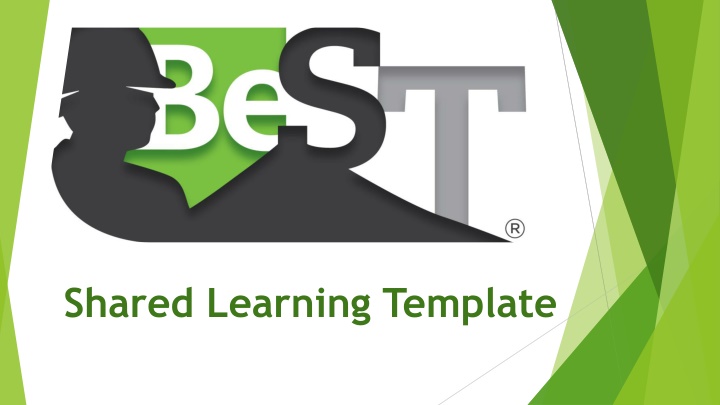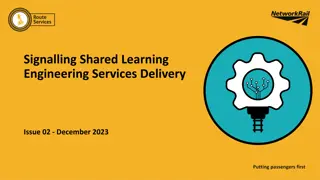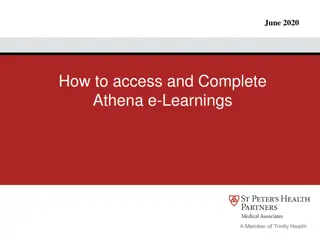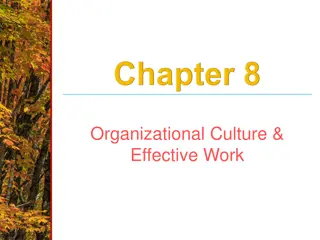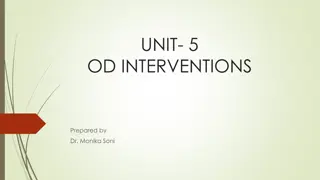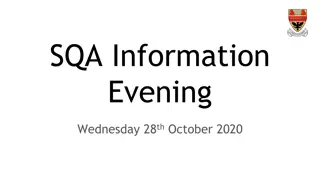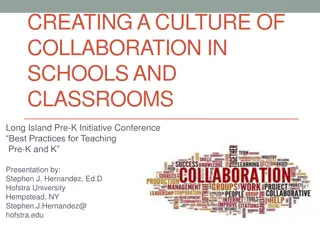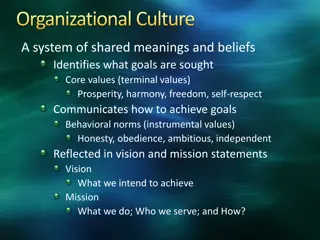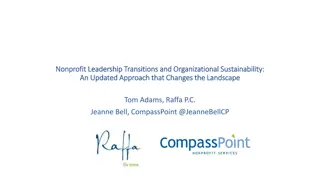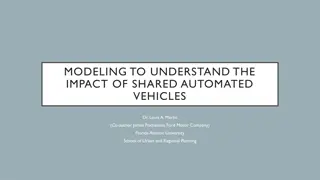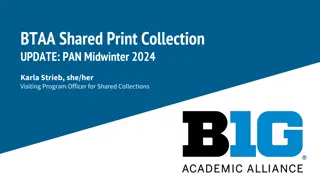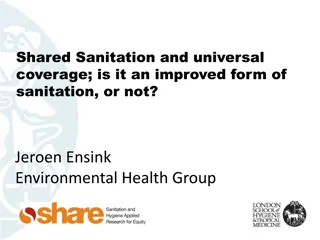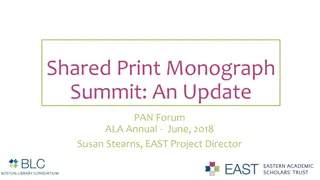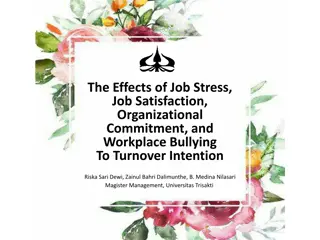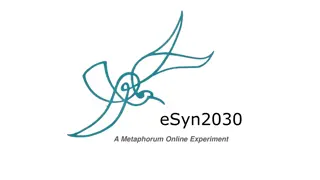Enhancing Organizational Learning through BeSafe Taranaki Shared Learnings
BeSafe Taranaki Shared Learnings aims to facilitate cross-organizational learning by sharing insights from incidents and investigations. The focus is on identifying key lessons, target audiences, necessary process changes, and safety expectations. Two types of learnings are emphasized: Immediate Notification for quick response and Incident Investigation Outcome for comprehensive insights. The incident investigation process involves initial responses, regulatory notifications, team formation, Root Cause analysis, and dissemination of shared learnings. Developing shared learnings involves various approaches tailored to each organization, with the goal of enabling improvement in procedures, processes, and systems. By sharing incident learnings, organizations can enhance safety, operational efficiency, and quality practices.
Download Presentation

Please find below an Image/Link to download the presentation.
The content on the website is provided AS IS for your information and personal use only. It may not be sold, licensed, or shared on other websites without obtaining consent from the author.If you encounter any issues during the download, it is possible that the publisher has removed the file from their server.
You are allowed to download the files provided on this website for personal or commercial use, subject to the condition that they are used lawfully. All files are the property of their respective owners.
The content on the website is provided AS IS for your information and personal use only. It may not be sold, licensed, or shared on other websites without obtaining consent from the author.
E N D
Presentation Transcript
BeSafe Taranaki Shared Learnings BeSafe Taranaki aims to promote Shared Learnings (learnings from incidents and incident investigations) to promote cross-organizational learning and performance across Taranaki businesses Shared Learnings prevents organizations from repeating the same mistakes and also allows it to take advantage of best practices. Our focus is on identifying the vital content of the lessons, the key audience for those messages, the processes that need changing and the revised expectations on safety. To help clarify and support this process, we are developing a simple templates to share this. If documented and disseminated properly, Shared Learnings provide a powerful method of improving worker safety, but also sharing ideas for improving work processes, operation, quality, and cost effectiveness. Learning should be deliberate. Organizations should be prepared to both share and take advantage of the key learning opportunities that projects provide
Shared Learning Type BeSafe aims to share two different types of learnings: Shared Learning: Immediate Notification This notification is made as soon as possible after an incident has occurred. Its intent is to be brief on what has happened, but to share opportunities where operations or equipment types should be immediately reviewed and potentially suspended (e.g. failure of a type of lifting device in a certain service). Share Learning: Incident Investigation Outcome These lessons are shared after the investigation into the incident has been completed. The aim is to summarise the incident down to key learnings from the investigation rather than every single finding, recommendation or corrective step.
Shared Learning Process Incident Investigation Each organization will follow a standard investigation process. This is likely having an initial immediate response to the incident (Emergency Response Team), formal regulatory notifications (Worksafe), release of any fast track alerts, then initiation of an Investigation Team. At this point, consideration may be given for a Shared learning Immediate Notification The investigation team typically uses a set of defined tools and processes (e.g. TRIPOD, Topset) to assess the barrier failures leading up to an incident and ultimately determine a series of Root Causes. A set of actions will be assigned within the organization to address shortcomings. In parallel with this, the Investigation Team will likely have a number of lessons to share across the organization.
Shared Learning Process Cont. Developing Shared Learnings Organisations will have different ways of managing the lessons learned from incidents. Some will have very detailed programs that tie into global reporting systems, while others will have simple local procedures, even through word of mouth. The intent of the BeSafe Shared Learnings are to share the story of what happened, and what was learned such that other organizations can assess the learnings against their own procedures, processes and systems and make improvements where necessary. At the conclusion of the Incident Investigation, BeSafe is recommending members to develop a Shared Learning from Incident Investigation
Shared Learning Process Cont. Anti-trust, competition, and privacy law considerations Companies are recommended to review their lessons learned from an anti- trust/competition/privacy law perspective before sharing them. As a general rule: Only include facts that have to be included to describe the incident. Do not name commercial organisations, e.g. suppliers, manufacturers, brands and operators. Do not name individuals. If naming commercial organisations is unavoidable, make sure comments are objective and not judgemental.
Instructions how to use the Shared Learnings templates 3. Use the grey area to place photos and diagrams Use as many photos and diagrams as needed Good quality, no distortions One or more photos or diagrams Structured and clean order when placing several items If available, insert QR code to access further material 1. Select type of one-pager, complete colored bar on the top. Red: Immediate Notification Blue: Shared Learnings: Incident Investigation Outcome 2. Complete title and text section (left part of the page) Short and meaningful title, one line maximum Do not change the wording of the sub-headings Be precise and short in describing the content of each section If needed, reduce the font size, but be aware that too much text may reduce the usability of the one-pager If available, insert hyperlinks to further material Do not use more than one page (if needed add an attachment) 4. Get review and approval Define together with responsible management, technical authority and/or HSSE the target group
SHARED LEARNING: IMMEDIATE NOTIFICATION DATE: XX/XX/XXXX Title Activity: Location: (check legal implication of naming site) Incident Description: State what kind of incident it was, and briefly describe what happened, using only the facts known at the time. Also use photographs/drawings in box opposite if they are available. Use this area to insert pictures, drawings and other illustrations Immediate Actions to be Taken: Set out the steps that company staff need to take e.g. additional checks, suspend certain activities, stop using particular equipment, raise awareness through safety meetings, etc.?
SHARED LEARNING: INCIDENT INVESTIGATION OUTCOME DATE: XX/XX/XXXX Title Activity: Location: (check legal implication of naming site) Use this area to insert pictures, drawings and other illustrations Incident Description: State what kind of incident it was, and briefly describe what happened, using only the facts known at the time. Also use photographs/drawings in box opposite if they are available. Potential Outcome: Briefly state (in one sentence) what the potential outcome of the incident could have been. Lessons Learned: Set out the steps that company staff need to take e.g. additional checks, suspend certain activities, stop using particular equipment, raise awareness through safety meetings, etc.? Causes (Immediate, Root Causes): Using the incident investigation outcomes, state the immediate and root causes.
